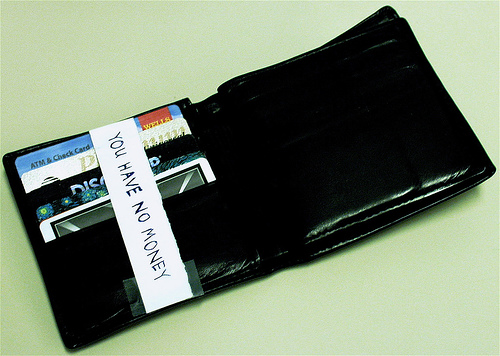- @ScottATaylor Thanks for following me. in reply to ScottATaylor #
- RT @ChristianPF: 5 Tips For Dealing With Your Medical Debt http://su.pr/2cxS1e #
- Dining Out vs Cooking In: http://su.pr/3JsGoG #
- RT: @BudgetsAreSexy: Be Proud of Your Emergency Fund! http://tinyurl.com/yhjo88l ($1,000 is better than $0.00) #
- [Read more…] about Twitter Weekly Updates for 2009-12-12
8 painless ways to save money
I saw this list on US News and thought I’d give my take on it.
- Get healthy. They are right. It is cheaper to be healthy…in the long run. Short-term, eating crap food is cheaper and obesity doesn’t get expensive until you are older. But remember, long-term planning is important. I intend to enjoy my old age, so I am working on losing weight and exercising. Fat and lazy is easy, but it won’t be in 50 years.
- Rethink your auto insurance. I don’t have an argument here. When I established my initial emergency fund, I set my deductibles to match it. We regularly review our policies to make sure they match what we need.
- Improve your credit scores. I don’t know what they were thinking with this one. If you’ve got lousy credit, it’s hardly painless to improve it. Digging out of a pit of debt hurts.
- Invest on the cheap. This is another one that’s hard to argue with. Low-fee funds are, by definition, cheaper. Will you get a better return on a fund with higher fees? It’s worth checking the historical return to see if the fee is justified.
- Think triple play. They recommend bundling your internet, TV, and phone. It is cheaper, but I don’t recommend it. I don’t like putting all of my eggs in one basket. If the cable goes down, or the the power goes out, I’d still like to be able to make a phone call, if I have to. My landline is independently powered, and I always make sure there is a corded phone plugged in somewhere. My basic landline only runs $35/month, so a bundle won’t save anything for me, anyway.
- Go prepaid with your cell phone. I have a coworker who pays, on average, $5/month for his cell phone. I use mine far more than he does. If you don’t talk much and don’t use data or texting, this can work out well for you.
- Shop online. I do shop online for a lot. I even buy my toilet paper online. For some things, I prefer to shop locally. When a store owner gets to know you, he can get you some fantastic deals, and give you advice that can save you a ton of money.
- Get cash back. I have a couple of decent cash-back credit cards, but I won’t use them. Until all of our credit card debt is paid, I won’t consider making regular use of any form of credit. Your mileage may vary, but that’s the condition I had to set on myself to make our debt plan work.
How many of these ideas do you use?
Is Your Budget Doing More Harm Than Good?
Do you stress over your money?
Is your spouse under the impression that you are constantly fighting over money?
Are you constantly fighting over money?
Have you completely eliminated your quality of life?
Do you spend hours each week analyzing where your money has gone?
A total budget can have a negative effect on the other parts of your life. If your spouse isn’t 100% on board, maybe he/she needs some “blow money” that doesn’t need to be tracked. If you aren’t spending enough time with your children because you are tracking expenses and adjusting your budget every day, you need to automate something, or at least loosen your standards. Maybe tracking every penny isn’t the right method of budgeting for you.
Don’t let the perfect budget destroy the rest of your life. If money is still a fight, you’re going to need to compromise on something, now, or you’ll end up compromising with the help of a divorce attorney.
Don’t forget, you are living now, not in the future. Plan for the future, but live in the present. There is a balance there, somewhere. Find it, or you and your loved ones won’t be happy.
Update: This post has been included in the Money Hacks Carnival.
My Financial Plan – How I Improve on Ramsey
In April, my wife and I decided that debt was done. We have hopefully closed that chapter in our lives. I borrowed, then purchased, The Total Money Makeover by Dave Ramsey.  budget” width=”300″ height=”213″ />We are almost following his baby steps. Our credit has always been spectacular, but we used it a lot. Our financial plan is Dave Ramsey’s The Total Money Makeover, with some adjustments.
budget” width=”300″ height=”213″ />We are almost following his baby steps. Our credit has always been spectacular, but we used it a lot. Our financial plan is Dave Ramsey’s The Total Money Makeover, with some adjustments.
Step 1. Budget:
The budget was painful, and for the first couple of months, impossible. We had no idea what bills were coming due. There were quarterly payments for the garbage bill and annual payments for the auto club. It was all a surprise. Surprises are setbacks in a budget.
When something came up, we’d start budgeting for it, but stuff kept coming up. We’re not on top of all of it, yet, but we are so much closer. We’ve got a virtual envelope system for groceries, auto maintenance, baby needs(we have two in diapers) and some discretionary money. We set aside money for everything that isn’t a monthly expense, and have a line item for everything that is. My wife is eligible for overtime and monthly bonuses. That money does not get budgeted. It’s all extra and goes straight on to debt, or to play catch-up with the bills we had previously missed. I figure it will take a full year to get all of the non-monthly expenses in the budget and caught up.
Step 2. The initial emergency fund:
Ramsey recommends $1000, adjusted for your situation. I decided $1000 wasn’t enough. That isn’t even a month’s worth of expenses. We settled on $1800, plus $25/month. It’s still not enough, but it’s better. Hopefully, we’ll be able to ignore it long enough that the $25/month accrues to something worthwhile.
Step 3. The Debt Snowball:
This is the controversial bad math. Pay off the lowest balance accounts first, then take those payments and apply them to the higher balance accounts. Emotionally, it’s been wonderful. We paid off the first credit card in a couple of weeks, followed 6 weeks later by my student loan. Since April, we’ve dropped nearly $10,000 and we haven’t made huge cuts to our standard of living. At least monthly, we re-examine our expenses to see what else can be cut.
Step 4. Three to six months of expenses in savings:
We aren’t on this step yet. In step 2, we are consistently depositing more, making us more secure every month.
Step 5. Invest 15% of household income into Roth IRAs and pre-tax retirement:
I have not stopped my auto-deposited contribution. It’s stupid to pass up an employer match. My wife’s company does not match, so she is currently not contributing.
Step 6. College funding for children:
We have started a $10 College fund.
Step 7. Pay off home early:
I don’t see the point in handling this one separately. Our mortgage is debt, and when the other debts are paid, we will be less than a year from owning our house, free and clear. This is rolled in with step three. All debt is going away, immediately.
Step 8. Build wealth and give!
We have cut off most of our charitable giving. Every other year, it has been a significant percent of our income, and in a few more years, will be so again. The only exception to this is children knocking on the door for fundraisers. I have no problems with saying no to a parent fundraising for their kid, but when the kids is doing the work, door-to-door, especially in the winter, I buy something. My son’s school, on the other hand, gets fundraisers ignored. When they come home, I send a check to the school, ignoring the program. I bypass the overhead and make a direct donation.
What Is Your Binary Options Strategy?
 When you are just entering the world of binary options trading or investing, you may be on the receiving end of a lot of advice. It is not uncommon to hear people tell you to implement different gambling strategies because binary options are based on chance more than anything else. You will also hear a lot of advice from those who say there are many good ways to develop an effective strategy using indicators and market signals. Some will insist that with proper analysis of market data, a solid strategy can be developed too.
When you are just entering the world of binary options trading or investing, you may be on the receiving end of a lot of advice. It is not uncommon to hear people tell you to implement different gambling strategies because binary options are based on chance more than anything else. You will also hear a lot of advice from those who say there are many good ways to develop an effective strategy using indicators and market signals. Some will insist that with proper analysis of market data, a solid strategy can be developed too.
Are they all correct? Interestingly enough, the answer is yes. The reason for this is simple, and as one expert writes, “there is no such thing as a perfect strategy for every trader. There is only a best strategy for each individual trader.” Thus, your strategy has to be shaped around a few things:
- Your willingness and ability to follow your chosen strategy.
- Your personality. For instance, are you restless if you are taking the safe route or a higher risk strategy?
- Your budget and goals,
Identifying the answers to these questions is the first step to formulating a strategy. You should also understand that the winning percentage of most strategies will be somewhat constant, but the total number of successful trades varies on an individual basis and is based entirely on the strategies used.
For instance, some investors want a high percentage of winning trades and are more comfortable with risk averse trading. Others are ready to take more risk and are entirely comfortable winning fewer trades if the returns on winning trades are dramatically higher. This enables them to implement higher risk trades. The interesting thing about strategies and the kinds of trades they generate is that they are all built from the same data.
The Data of Strategy
For example, almost all strategies will look at issues like market trends, trading trends, highs and lows, reversals, and various kinds of indicators. The reason that high and low trends pay off in strategy development is simple: binary options trading applies to whether or not an asset rises above a strike price or doesn’t. It is the proverbial “yes or no” part of the proposition and analysis for either outcome pays off.
As an example, a lot of risk-averse investors will look for breakouts. They use these for trend line investing, which can be as brief as sixty seconds to a day, but can be used to coordinate investing in the direction of a short trend. Although this seems complex, it really is not. The key is that analysis cannot be broad and across all available markets. Instead, focused analysis on a specific area will allow even a novice investor to analyze for a breakout and then invest in binary options accordingly.
Just being able to detect a reversal or a downward trend over the course of a day can yield a very rewarding investment. The key is to understand your strategy based on your budget, personality, and your ability to stick with the strategy, even if it does not yield immediate success. When you do this, and use the right tools for analysis, you can create an effective strategy that brings you closer to your goals.
This is a guest post.
Party Planning on a Super Tight Budget

- Image by Another Pint Please… via Flickr
I like to party.
Actually, that’s a lie. I’m too introverted to be a partier. More accurately, I like to throw two parties per year. I am also cheap frugal, so I try not to break the bank feeding fifty of my closest friends.
I have two entirely different parties. The first, known as the “Fourth Annual Second Deadly Sin Barbecue of Doom”, is a daytime party with a lot of food. The second is a Halloween party which takes place at night and refreshments are more of the liquid variety. Two different parties, two different strategies to keep them affordable.
Meat
For the Halloween party, meat consists entirely of a meat/cheese/cracker tray and a crock-pot full of either sloppy joes or chili. Quick and easy for about $20. For the barbecue, meat is the main attraction. The menu varies a bit from year to year. Last year, we had burgers, brats, hot dogs, a leg of lamb, pulled pork, and a couple of fatties. The year before, we had a turducken, but no fatties. From a frugal standpoint, the only meat mistakes were the turducken and the lamb. Neither are cheap, but both as delicious. The rest of the meat needs to be bought over the months preceding the party, as they go on sale. Ten pounds of beef, 2 dozen brats, 2 dozen hot dogs and a pork roast can be had for a total of about $75, without having to worry about picking out the hooves and hair. Fatties cost less than $5 to make.
Sides
Both parties have chips, crackers and a vegetable tray. Chips are usually whatever is on sale or the store brand if it’s cheaper. Depending on our time management, we try to cut the vegetables ourselves, but have resorted to paying more for a pre-made veggie tray in the past. This runs from $15-30.
Drinks
For kids and adults who don’t drink, I make a 5 gallon jug of Kool-Aid. Cost: About $3. For adults, I provide a few cases of beer. I don’t drink fancy beer, so this runs about $50. For the Halloween party, I throw open my liquor cabinet. Whatever is in there is available for my guests. The rule is “I provide the beer. If you want something specific, bring it yourself.” I have a fairly well-stocked liquor cabinet, but I don’t stock what I don’t like or don’t use. Part of the stock is what guests have left in the past. I don’t drink much and I buy liquor sporadically when I have a whim for something specific, so raiding the leftovers in the liquor cabinet doesn’t register on my party budget.
Potluck
While it seems like an obvious and easy way to keep costs down, I do not and will not expect my guests to bring anything. I throw a party to showcase either A) my cooking, or B) my Halloween display. I don’t charge admission. I don’t charge for a glass. I throw a party so I can have fun with the people I care about and the people the people I care about care about. I consider it a serious breach of etiquette to ask anybody to bring something. On the other hand, if someone offers, I will not turn it down.
Fun
The most important part of either of my parties is fun. All else is secondary. I seem to be successful, since reservations are made for my spare beds a full year in advance. Last Halloween, people came from 3 states.
Cost
How much do my mildy-over-the-top parties cost? The barbecue runs about $150-180 plus charcoal and propane. Yes, I use both. I’ll have 2 propane grills, 1 charcoal grill, and a charcoal smoker running all day. The Halloween party costs $80-100 for the basics. The brain dip costs another $20 and there’s always at least another $50 in stuff that seems like a good idea to serve.
Update: This post has been included in the Festival of Frugality.

